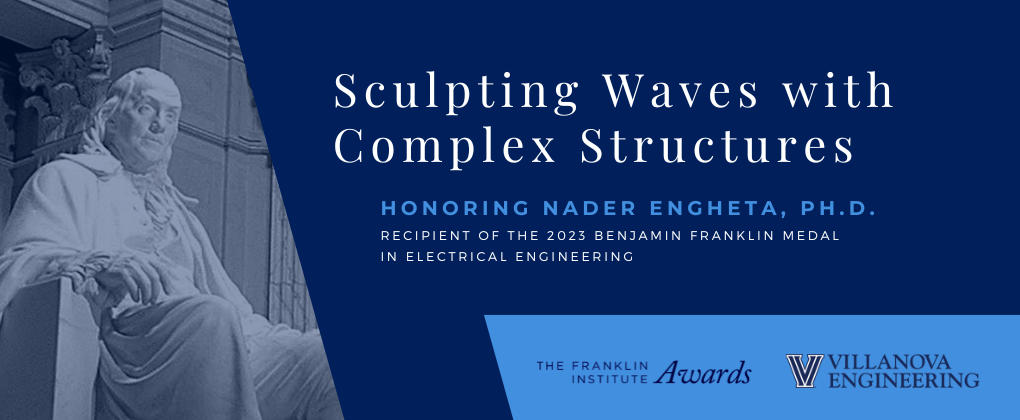SYMPOSIUM ABSTRACTS
Prof. Nader Engheta is considered by and large one of the fathers of electromagnetic metamaterials, due to his seminal contributions to the understanding, design and fabrication of engineered materials with extreme control over radio-waves and light. In this talk, I will discuss my research journey in metamaterials science, from the time I was a graduate student in Prof. Engheta’s group to today’s recent breakthroughs in nano-optics, electromagnetics and acoustics. I will discuss how materials suitably engineered at the nanoscale continue to surprise us, pushing the boundaries of wave physics and wave-matter interactions, tailoring the propagation of light, radio-waves and sound, and forming the basis for new technologies. In particular, I will discuss our recent work on scattering control, nonreciprocity, nonlocality and temporal modulations in metamaterials, for applications in augmented reality, radar technologies and optical computing. During my talk, I will also discuss the impact of these concepts from basic science to practical technologies of broad relevance to defense and commercial applications, and an outlook on the future of this exciting field of science.
Metasurfaces constitute a class of thin metamaterials, which can be used from microwave to optical frequencies to create new electromagnetic engineering devices. They are obtained by a dense periodic texture of small elements printed on or etched in a dielectric substrate. Changing the dimension of the elements, being the sub-wavelength 2D-periodicity equal, gives the visual effect of a pixelated image and the electromagnetic effect of a modulation of the equivalent local impedance boundary conditions (IBC). Molding IBC allows for a local modification of the dispersion equation and, at constant operating frequency, of the local wavevector; thus, enabling a transformation of surface or guided waves into different wavefield configurations with required properties. This talk will be focused in SWs manipulation control, with example in design of high-gain, low cross-pol antennas, Gaussian horns, multibeams, flat lenses, deflector, metaradomes, and topological line waves. Adaptive MTSs, composed of dynamically reconfigurable materials, would allow to explore new reconfigurable-beam antennas opening perspective in new generation wireless communication systems.
Optical communications has produced tremendous impact over the past 50 years, such that optical fiber-based communications dramatically impacted the way society transfers information. However, other key areas envisioned ~50 years ago are only recently emerging due to enhanced capacity needs and critical innovations. This presentation will highlight innovations involving the tailoring of optical waves and their emerging applications, including:
1. Free-space optical communications: As opposed to radio, optical links have high directionality and large capacity. There is great excitement in the recent emergence of deployed free-space optical links through air, outer-space, or underwater. Also to be discussed is capacity enhancement using multiplexing of multiple, orthogonal structured beams containing orbital angular momentum.
2. Non-conventional wavelengths: Fiber systems exist in the near-infrared, whereas free-space links can operate over a much wider frequency range, from Terahertz to visible light. Such systems may utilize: (a) high-speed components native to that frequency, and (b) wavelength-band conversion of near- infrared channels to other frequencies.
3. Optical signal processing (OSP): OSP holds the promise of high-speed operation and the avoidance of inefficient optical-electrical-optical conversion. Advances in photonic integrated circuits and manipulation of multiple optical-wave parameters may soon enable the emergence of OSP for high-performance functions.
Because time and space play a similar role in wave propagation, wave propagation is affected as well by spatial modulation or by time modulation of the refractive index. We will discuss the role of time modulation and show that sudden changes of the medium properties generate instant wave sources that emerge instantaneously from the entire wavefield and can be used to control wavefield and to revisit the way to create time-reversed waves.
Then we will extend the approach to periodic time modulation. The difference between periodic time modulation and periodic spatial modulation will be emphasized and the way an antenna radiates in these two kinds of situation will be discussed. Then the coupling of an antenna with the emitted wavefield in a time modulated medium will be discussed and we show that a kind of wave-particle duality can be observed.
The optical detection of single molecules originated in advanced research on optical storage in the 1980’s. Today, single molecules continue to provide a new view into the nanoscale where ensemble averaging is removed. Only a couple of nm in size, these objects can locally probe scultped light fields, such as the enhanced optical fields of metallic bowtie antennas. Another key application is super-resolution microscopy, which enables biological structures and behavior to be observed in fixed and live cells with resolutions down to 20-40 nm and below. For super-resolution imaging in thick cells, a new tilted light sheet design makes use of optical engineering methods which alter the fundamental way in which a microscope works, providing a simple, useful 3D microscope. Low temperature single-molecule imaging provides much improved localization precision in order to complement and annotate cryo-electron tomography images. Even the locations of nanoscale viral RNA structures in a mammalian cell undergoing coronavirus infection can be observed. While not all of these topics can be covered, they serve to illustrate the continuing richness of the field.
